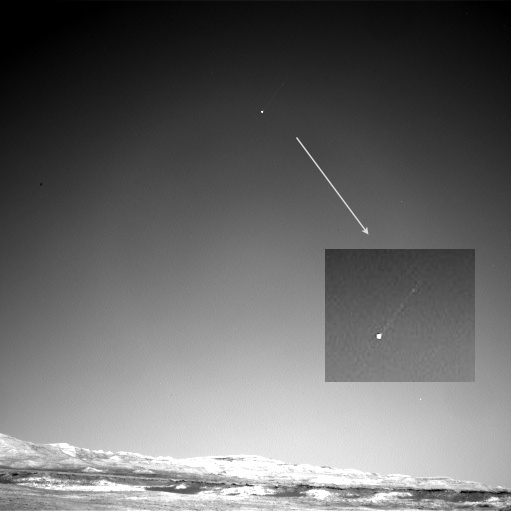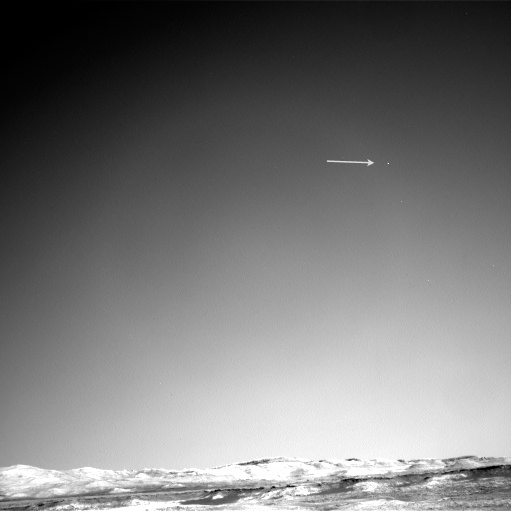It looks like you're using an Ad Blocker.
Please white-list or disable AboveTopSecret.com in your ad-blocking tool.
Thank you.
Some features of ATS will be disabled while you continue to use an ad-blocker.
16
share:
Hey, nice catch, Curiosity! I wonder if it might be possible to figure out where it hit.

mars.jpl.nasa.gov...

mars.jpl.nasa.gov...
edit on
29-11-2017 by Blue Shift because: (no reason given)
originally posted by: Blue Shift
Hey, nice catch, Curiosity!
mars.jpl.nasa.gov...
Have you got a news item for that...any comments from NASA.
“No one would have believed in the last years of the nineteenth century that this world was being watched keenly and closely by intelligences greater than man's and yet as mortal as his own; that as men busied themselves about their various concerns they were scrutinised and studied, perhaps almost as narrowly as a man with a microscope might scrutinise the transient creatures that swarm and multiply in a drop of water.”
― H.G. Wells, The War of the Worlds
Huh... This was the first thing that popped into my weird little brain. Cool picture, though.
Could be either a meteor or a cosmic ray strike on the camera's sensor.
Peeps at the Unmanned Spaceflight Forum suggest keeping an eye on any future HiRISE images of Gale crater for signs of a fresh impact.
Peeps at the Unmanned Spaceflight Forum suggest keeping an eye on any future HiRISE images of Gale crater for signs of a fresh impact.
very cool
i always forget curiosity has an night vision camera
s+f
i always forget curiosity has an night vision camera
s+f
a reply to: wildespace
unlikely that if it survived the atmosphere, it made any serious damage to the surface
unlikely that if it survived the atmosphere, it made any serious damage to the surface
originally posted by: wildespace
Could be either a meteor or a cosmic ray strike on the camera's sensor.
This thing has a long tail. Cosmic ray strikes are generally only a few pixels long. Here's a similar photo that came in today that shows a cosmic ray strike. The animation is the image with another one taken about 45 seconds after. Use Ctl-+ to zoom in.

edit on 30-11-2017 by Blue Shift because: (no reason given)
new topics
-
Cats Used as Live Bait to Train Ferocious Pitbulls in Illegal NYC Dogfighting
Social Issues and Civil Unrest: 40 minutes ago -
The Good News According to Jesus - Episode 1
Religion, Faith, And Theology: 2 hours ago -
HORRIBLE !! Russian Soldier Drinking Own Urine To Survive In Battle
World War Three: 4 hours ago -
Bobiverse
Fantasy & Science Fiction: 7 hours ago -
Florida man's trip overseas ends in shock over $143,000 T-Mobile phone bill
Social Issues and Civil Unrest: 7 hours ago -
Former Labour minister Frank Field dies aged 81
People: 9 hours ago -
SETI chief says US has no evidence for alien technology. 'And we never have'
Aliens and UFOs: 11 hours ago
top topics
-
President BIDEN Vows to Make Americans Pay More Federal Taxes in 2025 - Political Suicide.
2024 Elections: 16 hours ago, 19 flags -
Florida man's trip overseas ends in shock over $143,000 T-Mobile phone bill
Social Issues and Civil Unrest: 7 hours ago, 8 flags -
SETI chief says US has no evidence for alien technology. 'And we never have'
Aliens and UFOs: 11 hours ago, 7 flags -
Former Labour minister Frank Field dies aged 81
People: 9 hours ago, 4 flags -
Bobiverse
Fantasy & Science Fiction: 7 hours ago, 3 flags -
Ode to Artemis
General Chit Chat: 17 hours ago, 3 flags -
This is our Story
General Entertainment: 14 hours ago, 3 flags -
Cats Used as Live Bait to Train Ferocious Pitbulls in Illegal NYC Dogfighting
Social Issues and Civil Unrest: 40 minutes ago, 3 flags -
HORRIBLE !! Russian Soldier Drinking Own Urine To Survive In Battle
World War Three: 4 hours ago, 2 flags -
The Good News According to Jesus - Episode 1
Religion, Faith, And Theology: 2 hours ago, 0 flags
active topics
-
HORRIBLE !! Russian Soldier Drinking Own Urine To Survive In Battle
World War Three • 19 • : KnowItAllKnowNothin -
Florida man's trip overseas ends in shock over $143,000 T-Mobile phone bill
Social Issues and Civil Unrest • 14 • : Raptured -
DerBeobachter - Electric Boogaloo 2
Introductions • 14 • : ElitePlebeian2 -
LaBTop is back at last.
Introductions • 16 • : ElitePlebeian2 -
VirginOfGrand says hello
Introductions • 4 • : ElitePlebeian2 -
TLDR post about ATS and why I love it and hope we all stay together somewhere
General Chit Chat • 9 • : ElitePlebeian2 -
SETI chief says US has no evidence for alien technology. 'And we never have'
Aliens and UFOs • 32 • : bhtaylor53 -
Breaking Baltimore, ship brings down bridge, mass casualties
Other Current Events • 480 • : IndieA -
President BIDEN Vows to Make Americans Pay More Federal Taxes in 2025 - Political Suicide.
2024 Elections • 87 • : FlyersFan -
Thousands Of Young Ukrainian Men Trying To Flee The Country To Avoid Conscription And The War
Other Current Events • 134 • : Consvoli
16
